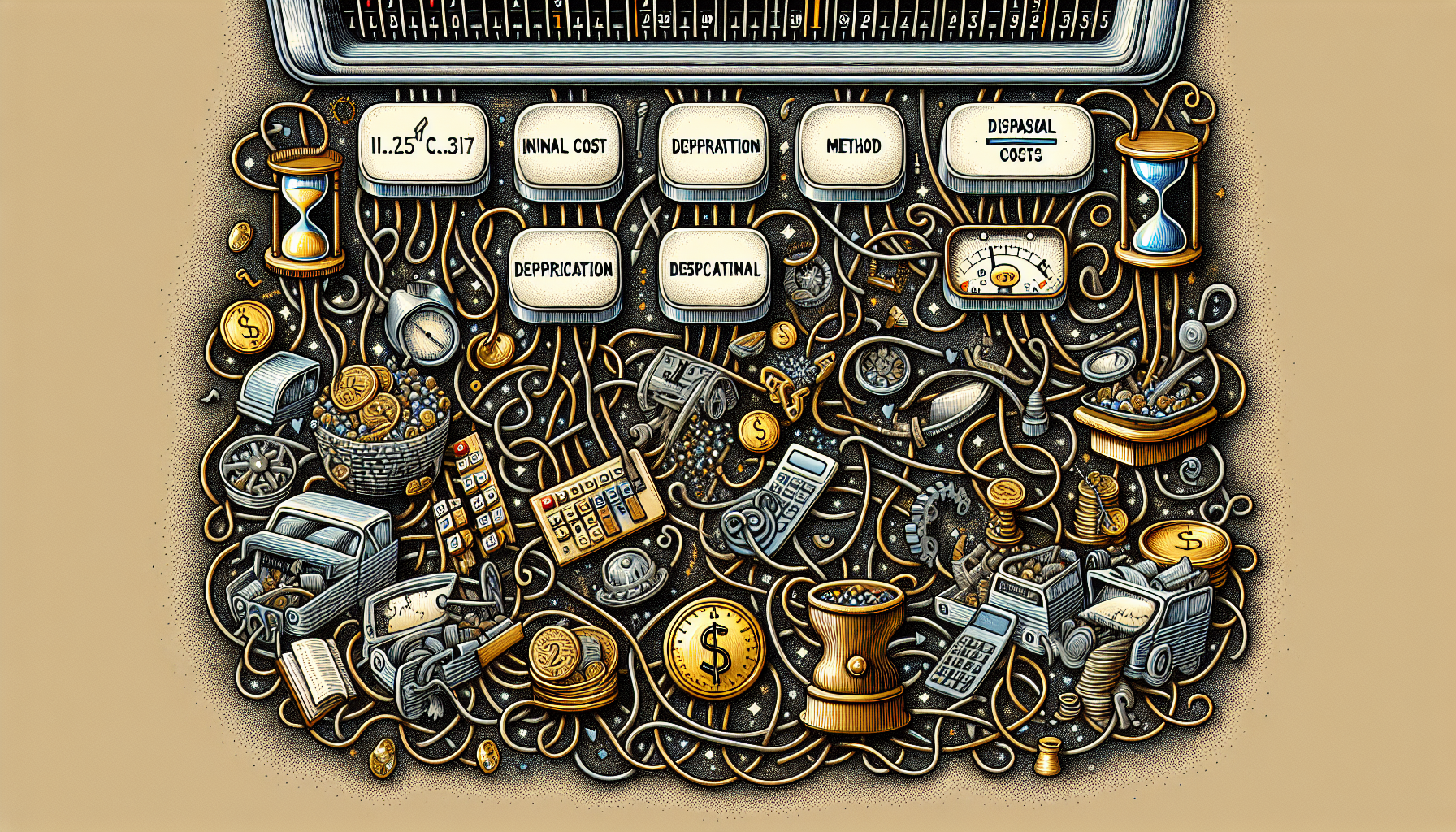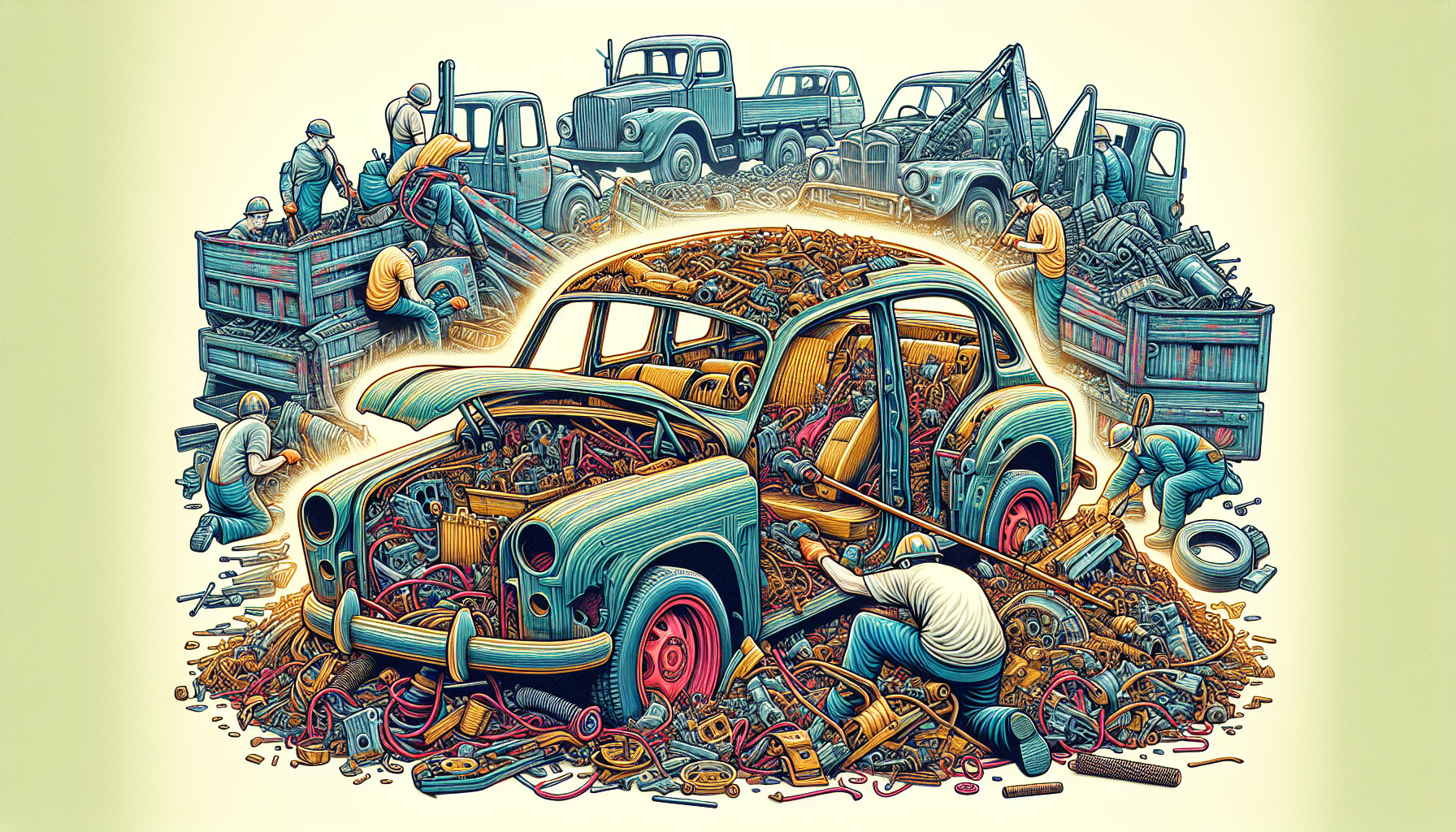If you’re asking ‘how is scrap value calculated,’ the simple answer is by subtracting accumulated depreciation from the asset’s original purchase price. This initial metric is essential for businesses planning for the future and individuals managing personal assets. We’ll guide you through the calculation methods that inform this value, striking the balance between a comprehensive approach and maintaining focus for readers keen on practical application.
Key Takeaways
- Scrap value, integral to financial planning and asset management, is the estimated value of an asset at the end of its useful life and impacts annual depreciation expenses.
- Scrap value is determined using various methods, with the straight-line and declining-balance methods being most common, and is influenced by factors such as market conditions and asset disposition costs.
- Scrap value estimation is crucial for accurate financial statements, influences tax reporting and insurance settlements, and requires careful consideration of market trends and asset condition to maximize recovered value.
Understanding Scrap Value

Scrap value, also known as salvage or residual value, is the estimated worth of an asset at the end of its useful life. This estimation matters greatly in financial planning and asset management, as it influences the annual depreciation expenses reported in balance sheets. From an accounting perspective, scrap value is what you expect to earn from selling the components or materials of an asset after it has been fully depreciated. The calculation of scrap value can vary based on the depreciation method applied by a company, influencing how the asset’s residual worth is estimated over time.
It’s worth noting that an asset with a zero scrap value indicates it’s expected to have no residual value after full depreciation. This has significant implications in accounting, especially regarding the journal entries for asset disposal. However, most physical assets have some scrap value due to the value of their individual components. For instance, a scrap vehicle may have value in its metallic components, tires, and other parts that can be sold separately.
The Role of Scrap Value in Depreciation
Scrap value isn’t just an abstract concept; it plays a crucial role in calculating an asset’s annual depreciation expense, which, in turn, affects net income and tax accounting. The accuracy of the estimated scrap value directly influences the net income levels of companies, as it helps them determine their annual depreciation expense.
Let’s illustrate this with an example. Suppose a company acquires a machine with an initial cost of $30,000 and a useful life of 10 years. At the end of its life, the machine is estimated to have a scrap value of $2,000. Using the straight-line depreciation method, the company would incur an annual depreciation expense of $2,800. This depreciation expense directly impacts the company’s financial statements by affecting the reported level of net income and depreciation expense.
Scrap Value vs Salvage Value
At this point, you might be wondering about the difference between scrap value and salvage value. While the terms are often used interchangeably, they represent slightly different concepts. Scrap value is the value of dismantled material from an asset that no longer serves its original purpose. In contrast, salvage value is the estimated residual worth of a fixed or physical asset after it has reached the end of its useful life.
In simpler terms, salvage value assumes some residual functionality or usefulness of the asset in its entirety. On the other hand, scrap value refers to the worth of an asset only in terms of its material components when sold as scrap. Both these values play a significant role in financial planning and decision-making.
Calculating Scrap Value: Key Methods

Now that we understand what scrap value is and its role in depreciation, let’s delve into how we calculate it. There are two common methods used to calculate scrap value: the straight-line depreciation method and the declining-balance method. These methods help in determining the remaining value of an asset over time. These methods offer different approaches to estimating the annual depreciation and residual amount of the asset, influencing the calculated scrap value.
Each method has its advantages and disadvantages, and the choice between them can greatly impact the estimated scrap value of an asset. Let’s explore these methods in detail to better understand how they affect the asset’s residual worth estimation.
Straight-Line Depreciation Method
The straight-line depreciation method is among the simplest ways to calculate depreciation and scrap value. It involves evenly spreading the cost of an asset over its expected useful life. This method provides a consistent value of loss each accounting period, making it easy to calculate and understand.
The formula for the straight-line depreciation method is fairly simple: (Cost of asset − Scrap value) / Useful life. This calculation gives you the annual depreciation expense, which you can then subtract from the initial cost each year to find the book value of the asset. At the end of the asset’s useful life, the remaining book value is the estimated scrap value.
Declining-Balance Method
The declining-balance method, on the other hand, is an accelerated depreciation system. This method applies a fixed percentage rate to the asset’s remaining book value each year, which results in larger depreciation expenses during the initial years of the asset’s life.
Under the declining-balance method, the salvage value is calculated based on the asset’s year-end book value, which has been reduced by depreciation at a specified rate each year. This method can be more accurate for assets that lose value quickly, such as vehicles and technology equipment.
Factors Influencing Scrap Value

Just like the value of a new fixed asset depends on various factors, the scrap value of an asset is influenced by several considerations. These include its initial cost, the depreciation method employed, and the estimated useful life.
Other factors can also play a role. For example, the costs associated with disposing of an asset and the land value where it resides can affect its ultimate scrap value.
In the case of leased cars, market conditions, including current material prices such as steel and aluminum, can influence the scrap value, apart from the terms of the lease and the vehicle’s condition.
Negative Scrap Value
There are situations where the scrap value of an asset can go negative. This occurs when the cost of disposing of the asset is greater than its value. In such cases, the disposal of the asset results in a cash outflow, causing the scrap value to become negative.
When an asset has a negative scrap value, it results in a net cash outflow and is recognized as an expense on the financial statements. This can have important implications for the financial health of the company and needs to be taken into account in financial planning and asset management.
Practical Applications: Vehicles and Equipment

While understanding the concept of scrap value is essential, applying it to real-world assets can be even more revealing. The scrap value of vehicles, for instance, is heavily influenced by factors such as:
- make
- model
- year
- mileage
- overall condition
Vehicles that are drivable typically have a higher scrap value than those that are not, due to their potential for resale at a higher price. Moreover, salvageable parts such as starters, wheels, and new tires can be sold separately, further increasing the total scrap value of a vehicle. Therefore, staying informed about current scrap prices can help owners choose the best time to sell scrap vehicles for the most favorable financial return.
Leased Cars
The concept of scrap value also applies to leased vehicles. In this case, the scrap value is the estimated value at the end of the lease term, as determined by the leasing firms. These firms typically calculate the scrap value based on the initial value of the car, applying a specified percentage to it.
This estimated value is important as it can impact the residual amounts due at the end of the lease term. It also provides a benchmark for the lessee to decide whether to purchase the car at the end of the lease or return it to the leasing firm.
Maximizing Scrap Value
Once you understand the factors that influence scrap value, the next step is to maximize it. This involves a combination of timely market action and awareness of current prices. For instance, knowing when to sell your scrap materials can help prevent value decrease due to changes in market dynamics such as energy and production costs, supply and demand, and the cost of virgin metals.
Additionally, ensuring fair pricing for vehicles that are still drivable or have salvageable parts can significantly increase your scrap value. In the case of vehicles, requesting an itemized breakdown when sending a vehicle to the salvage yard can provide a clear understanding of the car’s valuation. It’s also important to avoid delays when sending a vehicle to the rescue yard, as the value of the vehicle, particularly the parts subject to rapid deterioration, diminishes over time.
Scrap Value in Insurance and Financial Statements
The scrap value has an impact on more than just depreciation calculations. It is also a crucial factor in insurance settlements and financial statements. A substantial scrap value can lead to a significant influence on the total depreciation expense claimed over an asset’s lifetime for tax purposes.
In the insurance industry, scrap value is deducted from loss settlements when an asset, such as an automobile, is retained by the insured rather than being sold or disposed of by the insurance company. This impacts the final compensation provided to the insured. Furthermore, the scrap value is considered as the recoverable amount for damaged or abandoned property, which again impacts the settlement amount. For example, in auto insurance, the loss suffered by the insured is adjusted by deducting both the deductible amount and the scrap value to calculate the settlement check.
Examples of Scrap Value Calculation
Knowing how to calculate scrap value is essential to accurately assess the value of your assets. The scrap value of an asset is determined by subtracting the accumulated depreciation from the initial purchase cost. This calculation helps in estimating the remaining value of the asset..
Let’s consider an example using the straight-line depreciation method. If a company vehicle, which is an asset, was purchased for $20,000, with an estimated useful life of 5 years and a scrap value of $3,000, the asset’s annual depreciation expense, also known as the annual depreciation cost, would be calculated as ($20,000 – $3,000) / 5, which equals $3,400.
At the end of its useful life, the book value of the vehicle would be its scrap value of $3,000. This example illustrates how scrap value is factored into depreciation calculations and how it impacts the value of an asset over time.
Best Practices in Scrap Value Estimation
When it comes to scrap value estimation, precision is key. Accurate calculation of scrap value enhances the accuracy of financial analysis and supports informed decision-making. The straight-line depreciation method, due to its simplicity and uniform asset write-off, is often suitable for some scrap value estimations.
However, no estimate is foolproof. Businesses should be prepared for unexpected circumstances, such as the possibility of negative scrap values. Having strategies in place to address these scenarios, including a solid understanding of financial accounting, can help guard against potential financial losses.
Summary
Scrap value, the hidden treasure in depreciated assets, plays a crucial role in financial planning, depreciation calculations, insurance settlements, and more. Understanding how to calculate and maximize scrap value can enhance the accuracy of financial analysis and support informed decision-making. Whether it’s a leased car, a piece of industrial equipment, or an insurance settlement, recognizing and leveraging the scrap value can lead to significant financial gains.
As we’ve seen, several factors influence scrap value, from the initial cost of the asset to the method of depreciation employed. By staying informed about these factors and current market prices, you can choose the right time to sell scrap materials for the most favorable financial return. Remember, every asset has a silver lining, and that lining is its scrap value.
Frequently Asked Questions
How do you calculate scrap price?
To calculate scrap price, divide the amount of scrap produced in a given time period by the total amount of output in that same time period.
How do you determine salvage value?
To determine salvage value, you calculate it by deducting the depreciation of the machinery from its original cost. This gives you the value of the equipment or machinery after its useful life, as it’s termed the salvage value.
What factors influence the scrap value of an asset?
The scrap value of an asset is influenced by its initial cost, depreciation method, estimated useful life, and disposal costs. These factors determine the residual value of the asset when it reaches the end of its useful life.
What is a negative scrap value?
A negative scrap value occurs when the cost of disposing an asset is greater than its value, resulting in a net cash outflow.
How can I maximize the scrap value of my assets?
To maximize the scrap value of your assets, monitor market dynamics, ensure fair pricing for drivable vehicles or salvageable parts, and avoid delays in selling scrap materials.
For more information visit https://www.carmula.com/





 Who We Are
Who We Are Coverage Area
Coverage Area Donate
Donate